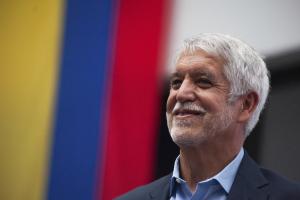 Read More
Read More
This mayor’s innovative leadership changed everything

Former Mayor of Bogotá, Enrique Peñalosa Londoño. AP Photo/Chepa Beltran
Listen to This Article
As a two-time mayor of Bogotá, Enrique Peñalosa Londoño drove innovations that both transformed his city and reshaped how people everywhere move. Perhaps most renowned is TransMilenio, a rapid bus system he introduced in 2000, which is now a “lifeline” for millions of people in and around Bogotá and serves as a global model that has been adopted in cities worldwide.
Peñalosa—who served two terms as mayor, one from 1998-2001 and another from 2016-2019, when he was a Bloomberg Associates mayor—is now offering lessons on impactful leadership in his new book, Equality and the City: Urban Innovations for All Citizens. He recently sat down with Bloomberg Cities to discuss how his approaches as mayor—including an early focus on building a special team dedicated to innovation and an “obsession” with equality—helped make his city a global pioneer.
Transforming what everyone believes local government can achieve.
Every mayor works hard to build the right team when they get started. But Peñalosa broke from what was business as usual in a few key ways. First, he recalls, he scoured Colombia for talent—rather than limiting himself to those already based in Bogotá—and was careful to include voices from outside his own party. That enabled him to assemble a unique team with dynamic young innovators suited to his ambitious plans.
But perhaps most important, he took pains to break down barriers and internally share his vision in as much detail as possible from the jump. This helped ensure everyone had buy-in to his wide-ranging proposals—that they were motivated and aligned with key goals. That, in turn, incubated a new culture where everyone in his administration felt like an important part of the team.
One specific approach he took to achieve this was to shorten feedback loops and reduce the filter between staff and the mayor. He set up a personal voicemail available to some 300 staffers so anyone—including those well below him on the org chart—could be in touch directly. (His first term was in the days before WhatsApp, he notes.) This doubled as a forum for him to provide positive feedback to team members he might not normally interact with.
Peñalosa also pushed his department heads to build their own teams, rather than micromanaging appointments; he felt empowering his agency heads was crucial. Throughout, the emphasis was on transforming what everyone believed local government could achieve—starting with its own employees.
“Government can be exciting and a place for creativity and a place to make lives better and not just some routine, boring thing,” he says.
Turning principles into concrete projects.
All mayors have a worldview or set of principles they bring to the job. Peñalosa managed to connect his strong views about local government’s purpose with concrete challenges that were ripe for new thinking.
“I think the most important thing is to have a vision,” he says, adding, “In my case, I was obsessed with equality.”
For Peñalosa, this often translated to a focus on equal access to public space, whether parks, waterfronts, or transit. And it could start with something as simple as sidewalks. Only about 10 percent of residents owned cars when he entered office, but sidewalks were practically nonexistent in the city, he recalls, and when they did exist, they often doubled as parking lots. Rather than tinker around the edges, he changed the game, pursuing TransMilenio, walkways, and dozens of miles of protected bikeways before many other cities had committed to them at such scale.
Meanwhile, his twist on the “walking school bus,” which was among the winners of the Bloomberg Philanthropies 2016 Mayors Challenge, has helped thousands of students in dozens of schools learn at the same time that they commute safely on local roads.
All the while, he was steadfast in using the experience of lower-income residents as a measuring stick for initiatives. “Somebody on a $100 bicycle is equally important as someone in a $100,000 car,” he says.
Choosing the right battles.
Many of Peñalosa’s most successful transit initiatives were controversial—even spawning unsuccessful impeachment attempts from opponents. But he says that doing things that generate opposition can, within reason and the law, be a sign that a mayor is onto something promising. The best mayoral visions, he says, have “teeth”—a clear focus that will guide city leaders when the going gets tough.
At the same time, any city leader will seek to avoid conflict when it’s in the public interest. He recalls in his book one case when he was faced with the prospect of having to comply with a court order to evict low-income residents who were encamped on the outskirts of the city. Instead, Peñalosa convinced the landowner to accept a payout to let the community continue to grow. He then proceeded to integrate these residents into civic life and provide essential services like sewage.
One lesson here, Peñalosa says, is that city leaders can’t plan everything, nor can they win every battle. What they can do is be nimble and respond to changing circumstances, such as the current trend toward hybrid work in cities, in a way that is consistent with their vision. This sort of innovation capacity helped him be effective as mayor, and it has helped his successors find success as well. Mayor Claudia López steered her own Bloomberg Philanthropies Global Mayors Challenge-winning idea: “care blocks” that provide hyper-local education and self-care opportunities for unpaid care workers, especially women. The program continues to thrive under current Mayor Carlos Fernando Galán, who succeeded López in January.
“Mayors [don’t just make] streets or bikeways, or parks or cultural centers,” Peñalosa says. They also have to help cities decide how they want to live as society changes around them—and be ready to change themselves.
“Our paradigm has to adjust to these new realities,” he says.
